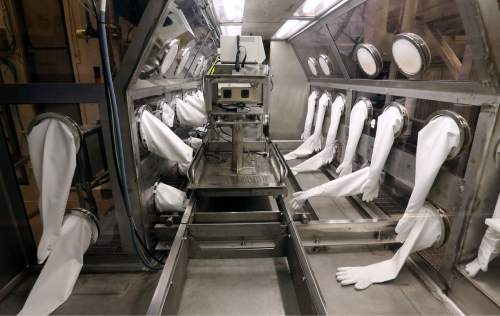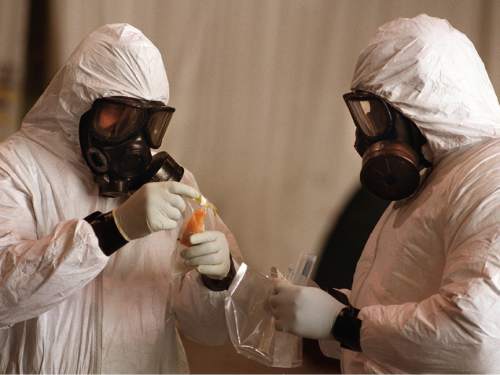This is an archived article that was published on sltrib.com in 2016, and information in the article may be outdated. It is provided only for personal research purposes and may not be reprinted.
Workers in June decontaminated a laboratory that received live anthrax samples from Dugway Proving Ground, according to documents released Wednesday.
There were no reports of the anthrax sickening anyone in Utah or in any other states or countries that received the live samples.
In Utah, the contamination was confined to a biological safety cabinet, where scientists in protective gear had worked with the spores the previous month, according to a report the state provided to the Centers for Disease Control and Prevention. Workers opted to follow a CDC recommendation and decontaminate the entire lab.
The Utah Department of Health, which took the lead in discussing the situation with the CDC, provided the information Wednesday in response to a records request filed first by the Citizens Education Project and then by The Salt Lake Tribune.
The Health Department redacted the name of the lab.
Allyn Nakashima, the state epidemiologist, said the Department of Defense has told the states not to disclose the laboratories that received the shipments. Nakashima did say the lab in question did not belong to the Health Department or the Utah Department of Agriculture and Food, which is also discussed throughout the documents.
One email from an assistant attorney general, which was part of the information released Wednesday, implied a private-sector lab in Utah received the anthrax shipment.
Health Department spokesman Tom Hudachko said Wednesday that his agency considers the matter closed.
"We worked with CDC and the individual lab," Hudachko said, "to make sure the sample was properly disposed of and the lab cleaned."
It was revealed last year that Dugway Proving Ground, a U.S. Army testing center in Utah's west desert, had for years been using a faulty procedure for neutralizing anthrax samples that were to be shipped to other labs for research. The information provided Wednesday was the first discussion of what transpired when live anthrax was discovered at a Utah lab.
Steve Erickson, who is with the Utah-based Citizens Education Project and who filed the original records request with the Health Department, said Dugway is proliferating potential weapons of mass destruction.
"It's a very out-of-control program," Erickson said. "The more you give access to these types of materials to disparate laboratories, the more potential for a screw-up or for someone to abscond with these pathogens."
Erickson said the problems at Dugway should be of particular interest, given that Sen. Orrin Hatch, R-Utah, is pushing a plan in Congress to expand the Utah Test and Training Range. That Air Force range sits adjacent to Dugway, and Erickson believes an additional buffer between Dugway and the public will encourage more open-air testing of biological and chemical weapons in the west desert.
"The political establishment just fawns all over Dugway," Erickson said, "while [it has] periodic screw-ups that have potential for some serious problems."
Most of the documents released Wednesday were emails between state employees and the CDC. They show the confusion that unfolded as the Dugway mistakes were coming to light.
In a May 29 email, Nakashima said she had a conversation with a CDC official who told her no Utah labs received the live Dugway anthrax shipments. Then, "5 minutes later," Nakashima wrote, another CDC official called her to say one Utah lab received a shipment.
Later that day, Nakashima emailed one of those CDC officials to say the Utah lab needed "to reopen so they are eagerly awaiting the decontamination recommendations" the CDC promised.
After receiving CDC instructions, Utah workers had to receive permission from another federal agency, the Environmental Protection Agency, for emergency use of a restricted pesticide to decontaminate the lab.
The decontamination was performed June 12.
On Wednesday, Nakashima said she was concerned someone in Utah could have been sickened by anthrax. She was upset that she read about the problems at Dugway in The Washington Post and that the CDC didn't contact her office first.
"We didn't think that was appropriate, that was all," Nakashima said.
She believes the CDC has improved its communications in the past eight months and will notify her of future problems.
Twitter: @natecarlisle





